Community Continues from Afar: Highlights of the NYSCF Innovators Retreat
NewsEach year, current NYSCF – Robertson Investigators, NYSCF – Druckenmiller Fellows, and NYSCF Research Institute scientists gather for the NYSCF Innovators Retreat: one week of discussion and camaraderie highlighted by powerful research.
This year, in the wake of the COVID-19 pandemic, the retreat was held virtually, but the science and spirit were just as strong. Each investigator presented their latest research (all confidential) to get cross-disciplinary feedback from their peers and form new connections. Participants also attended two poster sessions to discuss groundbreaking work with the program’s postdoctoral fellows. And for the first time ever, the retreat included panel discussions on big data and clinical translation, topics especially relevant for scientists in biomedical research.
Big Data, Artificial Intelligence, and Disease Research
The backbone of science is data, and with recent advancements in tools to generate data as well as artificial intelligence, finding ways to manage and interpret enormous data sets has become critical for scientists in many disciplines. At the retreat, a panel discussion unpacked the opportunities and challenges that big data provides as well as how it is allowing approaches that would have been unthinkable just a decade ago. At that time, generating data was the limiting factor, but now, analyzing it is.
“In our work, we are making healthy and diseased cells from stem cells and then screening very rich microscopy images of them for lots of characteristics, generating huge data sets,” remarked NYSCF Senior Research Investigator Bjarki Johannesson, PhD. “After just a few months, we had generated 60 terabytes of data.”
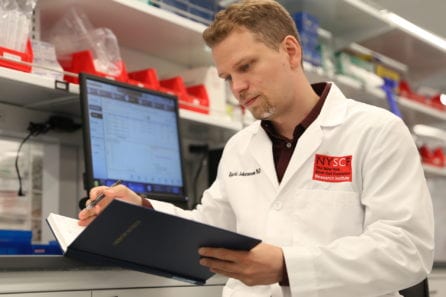
For context, 60 terabytes is roughly the equivalent of what 750 MacBook Pros could hold. Dr. Johannesson’s team takes this data and uses artificial intelligence to scan through it, pulling out new and targetable features or patterns undetectable by humans that may be relevant for disease.
“In pharma, drugs don’t get developed unless you have a clear target,” he explained. “We’re turning that process upside down by looking at everything rather than a single pathway.”
Vikram Khurana, PhD, of Brigham and Women’s Hospital and Harvard University is using big data to examine a phenomenon called ‘protein misfolding’ in neurodegenerative diseases like Parkinson’s. His earlier work used yeast to map genetic networks underlying these diseases as groundwork for studying them in humans.
“Just knowing gene-gene interactions in the human genome is a nascent endeavor right now, but that’s not true for other organisms,” he said. “I was impressed with the amount of data that was available in a very simple yeast cell. So we put networks together in a yeast cell, and are now using those principles to understand the genetics of disease in human cells.”
Chris Gregg, PhD, a NYSCF – Robertson Neuroscience Investigator Alumnus at the University of Utah, is using artificial intelligence to enrich diagnosis and progression tracking for cancer patients, which his team is now adapting for COVID-19. His platform, called Storyline, allows patients to record video responses to questions about their mental and physical health into their smartphone.
“We then use machine learning to analyze over 20,000 different features such as eye movement, blood flow patterns, and sentence structure to identify new indicators of disease and inform treatment strategies,” he explained.
“There’s a real opportunity to move the needle here in the clinical world. I know from my experiences as a patient myself that these people feel an urgent need for change, and using big data to find meaningful patterns is a way to make a difference quickly.”
Kristen Brennand, PhD, a NYSCF – Robertson Stem Cell Investigator at the Icahn School of Medicine at Mount Sinai, is using big data to understand neuropsychiatric diseases like schizophrenia.
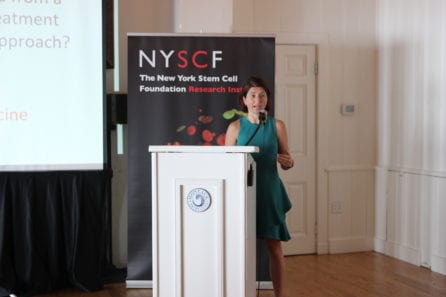
“If you have a population of patients with a disease, ultimately you want to treat them. We used to think there would be one cure for cancer and one cure for Alzheimer’s and one cure for psychiatric disease, but we increasingly realized there could be as many cures as there are patients,” she said. “We need to be better at grouping patients by their treatment response. So, for example, if you have a new drug that will only work on 2-3% of patients, how can you better predict who those patients are?”
Through close collaboration with data scientists, Dr. Brennand’s lab integrates big data with stem cell approaches to look at the genetics of patients with neuropsychiatric disease and their impact on the function of neurons made from patient stem cells — using this data to predict which patient populations will show which disease features.
The panelists agreed that with big data, it is important to ensure that what goes into your analysis is as high-quality, well designed, and unbiased as possible. As Dr. Khurana put it, ‘you put garbage in, you get garbage out.’ This is especially important for Dr. Gregg’s work, as he is capturing all of his data from scratch.
“The data we need to run this platform all comes from individual patient participants, it doesn’t already exist,” he added. “So, for us, a big challenge is getting the amount and quality of data we need – it’s all about scalability.”
What goes into data sets is also important when it comes to diversity.
“Biological data sets, especially when you’re looking at genetics, can be worthless if they aren’t diverse,” remarked Dr. Brennand. “The problem we often face is that we’re working with white male cell lines. We are trying very hard to increase diversity in our samples, because without it, the results will only apply to one group.”
Out of the Lab, Into the Clinic
The ultimate goal of every NYSCF Innovator is to help patients by taking their work from bench to bedside. Another panel discussion at the retreat included scientists whose work has already made this leap, who shared how they navigated the challenges that come along with it.
Paul Tesar, DPhil, a NYSCF – Robertson Stem Cell Investigator Alumnus at Case Western Reserve University, recently established a company called Convelo along with NYSCF – Robertson Stem Cell Investigator Alumnus Derrick Rossi, PhD, which came out of a discussion at an Innovators Retreat dinner.
Convelo builds off of Dr. Tesar’s discoveries in the lab — specifically, his work screening drugs on myelin, the insulation that surrounds neurons and helps them send signals, differentiated from the stem cells of patients with neurodegenerative disorders. This platform has helped Convelo identify drug candidates to move toward clinical testing, including several for multiple sclerosis, genetic leukodystrophies, and central nervous system aging and trauma.
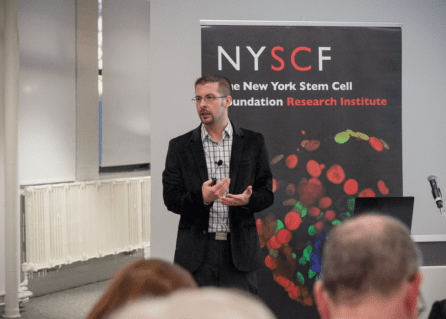
“Translating this platform to clinical use really began with what I learned at the NYSCF retreat,” said Dr. Tesar. “This is where I realized that what I was doing could have clinical benefit, as well as where Derrick and I first discussed how we could work towards that together.”
At Lund University in Sweden, NYSCF – Robertson Stem Cell Investigator Malin Parmar, PhD, has spent several years working with the pharmaceutical company Novo Nordisk on a stem-cell-based therapy for Parkinson’s disease.
“We knew that making dopamine neurons [the cells affected by Parkinson’s disease] from stem cells could be an interesting candidate for transplantation, but it took us some time to fully understand the steps that go into making a therapy,” she remarked. “We quickly learned that a clinical trial and a therapy are not the same thing – a therapy has to work for patients all over the world. I’m happy we have Novo Nordisk to help us through the process of establishing a therapy.”
Harvard’s Brian Wainger, MD, PhD, admits that his work had a few advantages for moving from the lab to the clinic. Using a stem cell model of ALS, NYSCF Senior Scientific Advisor Kevin Eggan, PhD, discovered that neurons made from the stem cells of ALS patients showed similar over-excitability to those in epilepsy patients. Dr. Wainger happened to know of an already-approved drug called retigabine that quells this hyperactivity in those with epilepsy. The team tested retigabine on a stem cell model of ALS, and saw that it was, in fact, effective. This led to a clinical trial in which 65 patients with ALS saw reduced neuron excitability when administered retigabine.
“We were able to start the trial less than two years after the paper came out,” recalled Dr. Wainger. “And we were very fortunate that on the clinical side, the infrastructure was there for us to launch from 12 sites very quickly.”
NYSCF – Robertson Stem Cell Investigator Vijay Sankaran, MD, PhD, of Boston Children’s Hospital and Harvard uses stem cells to develop better therapies for blood disorders.
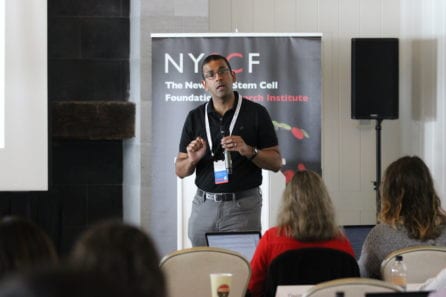
“As a pediatric hematologist and oncologist who sees patients and conducts research on rare genetic blood disorders, I’ve always been especially motivated to work toward therapies that can better treat patients,” he remarked.
Dr. Sankaran’s lab discovered a key genetic regulator of blood production that could serve as a good target for gene therapies. He licensed this discovery out to five different companies which are currently running clinical trials for treatments that target this regulator.
The panelists shared their tips for moving work into the clinic – touching on everything from proving the value of your work to the importance of support from your peers.
“To engage people running clinical trials, you really have to show that what you’re offering is low risk, and luckily we could do that since our treatment involved an already-approved drug,” said Dr. Wainger.
“Early findings are often met with skepticism,” agreed Dr. Sankaran. “You have to be very data-driven to prove the promise of your work and move things forward.”
For Dr. Parmar, having role models to rely on was an integral part of her journey.
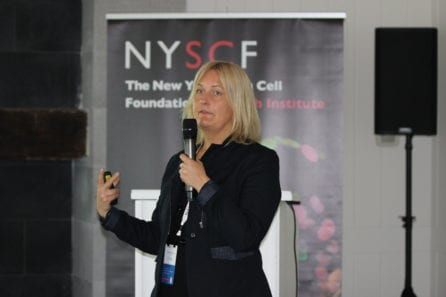
“Similarly to how you have mentors throughout your scientific training, you need role models for clinical translation,” she explained. “Having people who encourage you to move forward and existing in an environment that is supportive of that work was critical for me.”
All of the scientists acknowledged the importance of community in their journeys – specifically, the NYSCF community.
“I was really aided by my interactions with the NYSCF stem cell community. Having people around who will support you and engage with your work is a terrific advantage,” said Dr. Tesar.
“I agree with Paul completely,” added Dr. Sankaran. “Speaking with others who have been through the experience will help show you new avenues and opportunities. It’s incredibly valuable.”
The Power of Community
Each year, the graduating class of NYSCF – Robertson Investigators gives a toast to share their experiences within the community and their gratitude toward their peers.
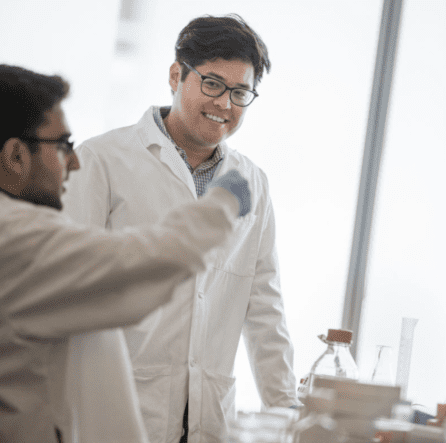
“NYSCF means an incredible amount to me,” remarked NYSCF – Robertson Neuroscience Investigator Justin Ichida, PhD, of the University of California, San Francisco, who was also one of NYSCF’s first NYSCF – Druckenmiller Fellows in 2007. “I became a part of this community back when I was a postdoc and the retreat was just six scientists meeting up for a few hours. It has grown so much since then and truly feels like a family.”
“I actually came across this program by accident and never thought I’d be able to be a part of it – it’s such a group of superstars,” added NYSCF – Robertson Stem Cell Investigator Kristy Red-Horse, PhD, of Stanford. “This community has become so integral to my career, and much of what my lab has accomplished has only been possible because of this award.”
Many investigators similarly expressed how the NYSCF – Robertson Investigator award, which confers unrestricted funding to early-career investigators, was a game-changer for their labs.
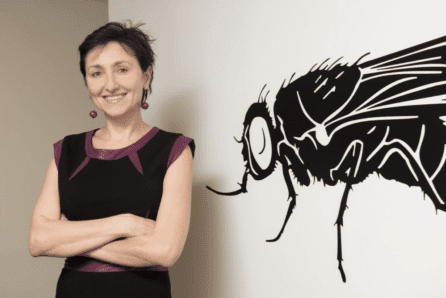
“It’s difficult to find funding for these ‘crazy ideas’ we have early on in our careers that could do a lot of good if they work,” said Dragana Rogulja, PhD, of Harvard. “This award has really made all the difference – it has made me feel so free and happy. I hope to pay you all back with a lot of good work.”
“NYSCF lifted a lot of barriers for me and inspired me to use my work to do good for the world,” remarked Hillel Adesnik, PhD, of the University of California, Berkeley. “I’ve made many great friends through this program and have drawn a lot of inspiration from them.”
“I first heard about NYSCF from another NYSCF – Robertson Investigator,” recalled Mitchell Guttman, PhD, of Caltech. “Starting your lab is a very stressful time, and I’m so grateful for the support provided not only by this funding, but by this community. It has been a wonderful five years and I look forward to the future.”
While we are sad to see the graduating group ‘leave’ the program, they will always remain a part of the NYSCF community, and we are excited to see the incredible strides they make toward improving the lives of patients in the coming years.